
The Blues are a New Zealand professional rugby union team based in Auckland, who play in the Super Rugby competition. Like New Zealand's four other Super Rugby teams, the Blues were established by the NZRU in 1996. One of the most successful teams in Super Rugby history, the Blues won the competition in its first two seasons, 1996 and 1997, and again in 2003 and 2024. Additionally, the team were finalists in 1998 and 2022, and semi-finalists in 2007, 2011 and 2023. They won a Trans Tasman competition in 2021.

The Hurricanes is a New Zealand professional men's rugby union team based in Wellington that competes in Super Rugby. The Hurricanes were formed to represent the lower North Island, including the East Coast, Hawke's Bay, Horowhenua Kapiti, Manawatū, Poverty Bay, Taranaki, Wairarapa-Bush, Wanganui and Wellington unions. They currently play at Sky Stadium, having previously played at the now-defunct Athletic Park.

Sonny William Williams is a New Zealand heavyweight boxer, and a former professional rugby league and rugby union player. He is only the second person to represent New Zealand in rugby union after first playing for the country in rugby league, and is one of only 43 players to have won the Rugby World Cup twice.
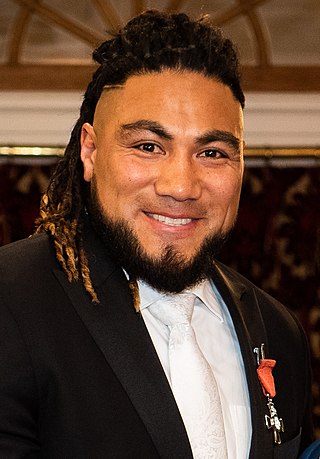
Ma'a Allan Nonu is a professional rugby union player from New Zealand who currently plays for the San Diego Legion in Major League Rugby (MLR). He plays in the inside centre, but can also cover outside centre and wing.

Conrad Gerard Smith is a New Zealand rugby union coach and former player, who played predominantly at centre. He captained the Hurricanes in Super Rugby, and played for New Zealand from 2004 until 2015. He was a key member of New Zealand's 2011 and 2015 Rugby World Cup winning teams. Following the 2015 World Cup he retired from international rugby and took up a contract with Pau in France, before retiring in 2018.

Thierry Dusautoir is a French former rugby union player who last played for France at international level and Toulouse in the French Top 14 club competition. He was called the "Dark Destroyer" during his career. Dusautoir was considered a strong ball carrier and possessed incredibly powerful and effective tackling. He was considered the best tackler in the world during his career.
The Ngati Porou East Coast Rugby Football Union (NPEC) is a constituent union in the New Zealand Rugby Union. It is located on the East Coast of the North Island, based in Ruatoria. It is the smallest Union in New Zealand in the sense of player numbers and population base. Due to the high number of players from the Ngati Porou iwi, the team is often referred to as Ngati Porou East Coast.

Jerome Kaino is a former New Zealand rugby union player.

Israel Jamahl Akuhata Dagg is a former New Zealand rugby union player who played for the Crusaders in Super Rugby. He has also played for the New Zealand Sevens team, and represents Hawkes Bay in the ITM Cup.
The 2005 New Zealand Rugby Union tour of Britain and Ireland was a Grand Slam Rugby Union tour played by the New Zealand National Rugby Union team, also known as the All Blacks, in the United Kingdom and in the Republic of Ireland against their respective national teams. Played through November, it consisted of 4 matches against Wales, Ireland, England and Scotland.
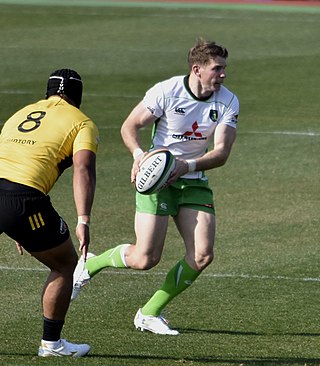
Colin Richard Slade is a retired New Zealand professional rugby union player. He played primarily at first five-eighth, as well as all other backline positions on occasions. He was first selected for the All Blacks in 2009. He was a key member of the 2011 Rugby World Cup winning team. He was also included in the 2015 Rugby World Cup, but played in only one match against Namibia. He thus became one of only 44 players who have won the Rugby World Cup on multiple occasions.
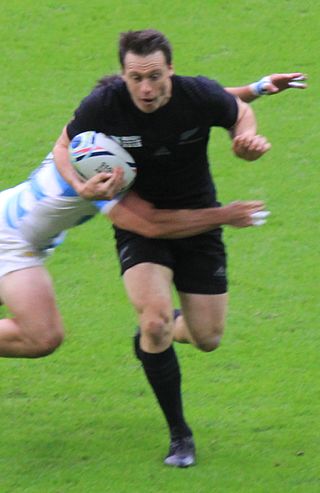
Benjamin Robert Smith is a retired New Zealand rugby union player, currently working for Super Rugby side Highlanders' management team. He formerly played for the Highlanders in the Super Rugby competition, Otago in the ITM Cup, Pau in the Top 14 and Kobelco Steelers in the Japan Rugby League One.

Aaron Wiremu Cruden is a New Zealand rugby union player, who plays for Waikato and formerly Montpellier, Manawatu and New Zealand internationally. Cruden's usual position is fly-half.
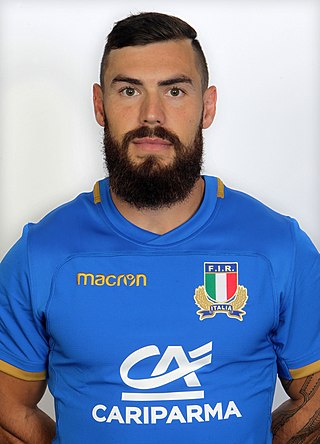
Jayden Hayward is a New Zealand-born rugby union player who played for the Italy national rugby union team and for Benetton Rugby. He can play as a fly-half, centre or fullback.

Beauden John Barrett is a New Zealand professional rugby union player who plays as a fly half for Japan Rugby League One club Toyota Verblitz and for the New Zealand national team.
George Moala is a professional rugby union player who plays as a centre for Top 14 club Clermont. Born in New Zealand, he represents Tonga at international level after qualifying on ancestry grounds.

Ryan Stevenson Crotty is a New Zealand-born rugby union Rugby player. He currently plays as a midfield back for the Kubota Spears in the Japanese Top League.
The 2013 Rugby Championship, known as The Castle Rugby Championship in South Africa, The Investec Rugby Championship in New Zealand, The Castrol Edge Rugby Championship in Australia and The Personal Rugby Championship in Argentina for sponsorship reasons, was the second edition of the expanded annual southern hemisphere championship consisting of Argentina, Australia, South Africa and New Zealand. New Zealand as the 2012 holders, was trying to keep their 100% winning record in the championship after winning six from six in 2012.
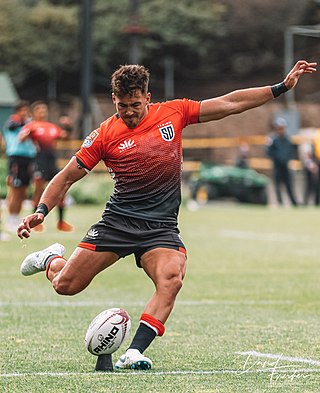
Luke Burton is an Australian rugby union player who currently plays for the San Diego Legion in Major League Rugby (MLR). He previously played for the LA Giltinis in the MLR. He can play as either a fly-half or centre.

The 2015 Rugby World Cup final was a rugby union match to determine the winner of the 2015 Rugby World Cup, played between reigning champions New Zealand and their rivals Australia on 31 October 2015 at Twickenham Stadium in London. New Zealand beat Australia 34–17, winning the World Cup for a record third time, and becoming the first team to retain the Webb Ellis Cup. The 51 points scored in this final is the highest of all Rugby World Cup finals.
















